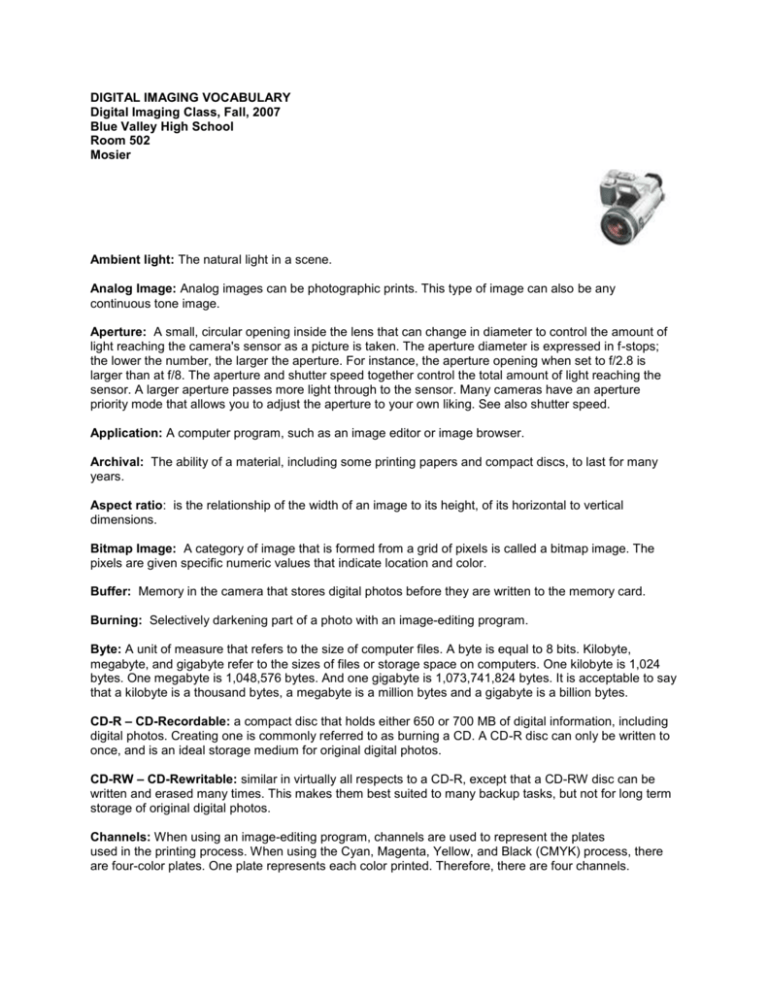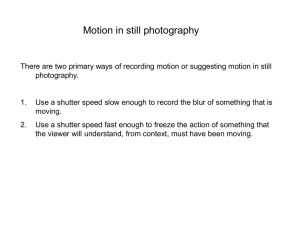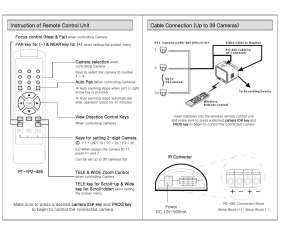Digital Imaging Vocabulary List
advertisement

DIGITAL IMAGING VOCABULARY Digital Imaging Class, Fall, 2007 Blue Valley High School Room 502 Mosier Ambient light: The natural light in a scene. Analog Image: Analog images can be photographic prints. This type of image can also be any continuous tone image. Aperture: A small, circular opening inside the lens that can change in diameter to control the amount of light reaching the camera's sensor as a picture is taken. The aperture diameter is expressed in f-stops; the lower the number, the larger the aperture. For instance, the aperture opening when set to f/2.8 is larger than at f/8. The aperture and shutter speed together control the total amount of light reaching the sensor. A larger aperture passes more light through to the sensor. Many cameras have an aperture priority mode that allows you to adjust the aperture to your own liking. See also shutter speed. Application: A computer program, such as an image editor or image browser. Archival: The ability of a material, including some printing papers and compact discs, to last for many years. Aspect ratio: is the relationship of the width of an image to its height, of its horizontal to vertical dimensions. Bitmap Image: A category of image that is formed from a grid of pixels is called a bitmap image. The pixels are given specific numeric values that indicate location and color. Buffer: Memory in the camera that stores digital photos before they are written to the memory card. Burning: Selectively darkening part of a photo with an image-editing program. Byte: A unit of measure that refers to the size of computer files. A byte is equal to 8 bits. Kilobyte, megabyte, and gigabyte refer to the sizes of files or storage space on computers. One kilobyte is 1,024 bytes. One megabyte is 1,048,576 bytes. And one gigabyte is 1,073,741,824 bytes. It is acceptable to say that a kilobyte is a thousand bytes, a megabyte is a million bytes and a gigabyte is a billion bytes. CD-R – CD-Recordable: a compact disc that holds either 650 or 700 MB of digital information, including digital photos. Creating one is commonly referred to as burning a CD. A CD-R disc can only be written to once, and is an ideal storage medium for original digital photos. CD-RW – CD-Rewritable: similar in virtually all respects to a CD-R, except that a CD-RW disc can be written and erased many times. This makes them best suited to many backup tasks, but not for long term storage of original digital photos. Channels: When using an image-editing program, channels are used to represent the plates used in the printing process. When using the Cyan, Magenta, Yellow, and Black (CMYK) process, there are four-color plates. One plate represents each color printed. Therefore, there are four channels. Charged Coupled Device (CCD): Sensors that are light sensitive and arranged into a grid called an area array. They are found in digital cameras, scanners and video cameras. or one of the two main types of image sensors used in digital cameras. When a picture is taken, the CCD is struck by light coming through the camera's lens. Each of the thousands or millions of tiny pixels that make up the CCD convert this light into electrons. The number of electrons, usually described as the pixel's accumulated charge, is measured, then converted to a digital value. This last step occurs outside the CCD, in a camera component called an analog-to-digital converter. CMOS – Complementary Metal-Oxide Semiconductor: one of the two main types of image sensors used in digital cameras. Its basic function is the same as that of a CCD. CMOS sensors are currently found in only a handful of digital cameras. CMYK – Cyan, Magenta, Yellow, Black: The four colors in the inksets of many photo-quality printers. Some printers use six ink colors to achieve smoother, more photographic prints. The two additional colors are often lighter shades of cyan and magenta. CompactFlash™: A common type of digital camera memory card, about the size of a matchbook. There are two types of cards, Type I and Type II. They vary only in their thickness, with Type I being slightly thinner. A CompactFlash memory card can contain either flash memory or a miniature hard drive. The flash memory type is more prevalent. Composition: The arrangement of elements in a picture. The elements are the subjects of the picture such as people, animals, mountains, lakes, trees, etc. Contrast : The difference between the darkest and lightest areas in a photo. The greater the difference, the higher the contrast. Digital camera: A camera that captures the photo not on film, but in an electronic imaging sensor that takes the place of film. Digital Images: An image that is electronically produced using digital cameras, scanners, software programs. The images are files that can be displayed on a computer monitor, printed on paper, or stored as a file on media like CD-ROMs. Digital Photography: The use of a digital camera to electronically capture and produce images using a CCD. Scanners, software, computers, and printers are used together with the camera to produce the finished image. Dodging: Selectively lightening part of a photo with an image editing program. Dot gain: is a phenomenon in printing and graphic arts whereby printed dots are perceived and actually printed bigger than intended. This causes a darkening of the screened images or textures, especially in the mid tones and shadows. This happens because of the viscosity of ink and its ability to spread through the paper as it is soaked in. Dot gain varies with paper type. Uncoated paper stock like newsprint paper shows the most dot gain. Download, downloading: The process of moving computer data from one location to another. Though the term is normally used to describe the transfer, or downloading, of data from the Internet, it is also used to describe the transfer of photos from a camera memory card to the computer. Example: I downloaded photos to my computer. DPI – Dots per inch: A measurement of the resolution of a digital photo or digital device, including digital cameras and printers. The higher the number, the greater the resolution. EXIF – Exchangeable Image File: the file format used by most digital cameras. For example, when a typical camera is set to record a JPEG, it's actually recording an EXIF file that uses JPEG compression to compress the photo data within the file. External flash: A supplementary flash unit that connects to the camera with a cable, or is triggered by the light from the camera's internal flash. Many fun and creative effects can be created with external flash. File: A computer document. File Format: This identifies the type of file compatible with specific computer systems and/or their applications. The most common file formats for digital photography are identified by three- character extensions such as TIF, JPG, EPS, GIF, BMP, or PSD. Fill flash: A flash technique used to brighten deep shadow areas, typically outdoors on sunny days. Some digital cameras include a fill flash mode that forces the flash to fire, even in bright light. Fire: Slang for shooting a picture. Example: I pressed the shutter button to fire. FireWire: A type of cabling technology for transferring data to and from digital devices at high speed. Some professional digital cameras and memory card readers connect to the computer over FireWire. FireWire card readers are typically faster than those that connect via USB. Also known as IEEE 1394, FireWire was invented by Apple Computer but is now commonly used with Windows-based PCs as well. Grayscale: A photo made up of varying tones of black and white. Grayscale is synonymous with black and white. Highlights: The brightest parts of a photo. Histogram: A graphic representation of the range of tones from dark to light in a photo. Some digital cameras include a histogram feature that enables a precise check on the exposure of the photo. Image browser: An application that enables you to view digital photos (such as iPhoto). Some browsers also allow you to rename files, convert photos from one file format to another, add text descriptions, and more. Image Capture: The process of using a device such as a scanner or digital camera to convert images into digitized data. Image processing: Computers and software programs that have the capability of performing enhancements, file conversions, special effects, and other modification to the structure or content of an image. Image editor: A computer program that enables you to adjust a photo to improve its appearance. With image editing software, you can darken or lighten a photo, rotate it, adjust its contrast, crop out extraneous detail, remove red-eye and more. Image resolution: The number of pixels in a digital photo is commonly referred to as its image resolution. Inkjet: A printer that places ink on the paper by spraying droplets through tiny nozzles. ISO speed: A rating of a film's sensitivity to light. Though digital cameras don't use film, they have adopted the same rating system for describing the sensitivity of the camera's imaging sensor. Digital cameras often include a control for adjusting the ISO speed; some will adjust it automatically depending on the lighting conditions, adjusting it upwards as the available light dims. Generally, as ISO speed climbs, image quality drops. JPEG: A standard for compressing image data developed by the Joint Photographic Experts Group, hence the name JPEG. Strictly speaking, JPEG is not a file format, it's a compression method that is used within a file format, such as the EXIF-JPEG format common to digital cameras. It is referred to as a lossy format, which means some quality is lost in achieving JPEG's high compression rates. Usually, if a highquality, low-compression JPEG setting is chosen on a digital camera, the loss of quality is not detectable to the eye. LCD: Liquid Crystal Display: a low-power monitor often used on the top and/or rear of a digital camera to display settings or the photo itself. Media: Material that information is written to and stored on. Digital photography storage media includes CompactFlash cards and CDs. Megabyte (MB): A measurement of data storage equal to 1024 kilobytes (KB). Megapixel: One million pixels. The term is used in reference to the resolution of a digital camera. The larger the megapixel value the higher the quality of the camera's output and the larger the file size. Memory Stick®: A memory card slightly smaller than a single stick of chewing gum. Like CompactFlash and SmartMedia, it is flash-based storage for your photos. NiMH: Nickel Metal-Hydride: a type of rechargeable battery that can be recharged many times. NiMH batteries provide sufficient power to run digital cameras and flashes. Online photo printer: A company that receives digital photos uploaded to its Web site, prints them, then sends the prints back by mail or courier. Panning: A photography technique in which the camera follows a moving subject. Done correctly, the subject is sharp and clear, while the background is blurred, giving a sense of motion to the photo. Pixels (Picture Element): Small dots that form an image. It is an abbreviation for picture element. Pixels contain numeric values based on the bit-depth of an image. An 8-bit grayscale image has pixel values that range from 0 to 255. Digital photographs are comprised of thousands or millions of them; they are the building blocks of a digital photo. PPI: Pixels Per Inch. A measure used in image resolution. Raster Images: Bitmap Images RAW: The RAW image format is the data as it comes directly off the CCD, with no in-camera processing is performed. RGB: Red, Green, Blue: the three colors to which the human visual system, digital cameras and many other devices are sensitive. Red-eye: The red glow from a subject's eyes caused by light from a flash reflecting off the blood vessels behind the retina in the eye. The effect is most common when light levels are low, outdoor at night, or indoor in a dimly-lit room. Resolution: Is the quality level of an image based on PPI. An image that is high in resolution shows more detail than an image that is low in resolution. Pictures that are high in resolution have a higher number of PPI. Saturation: How rich the colors are in a photo. Scanner: Hardware that converts printed material such as analog photographic negatives or prints digital information. Sensitivity: See ISO speed. Serial: A method for connecting an external device such as a printer, scanner, or camera, to a computer. It has been all but replaced by USB and FireWire in modern computers. Sharpness: The clarity of detail in a photo. Shutter speed: The camera's shutter speed is a measurement of how long its shutter remains open as the picture is taken. The slower the shutter speed, the longer the exposure time. When the shutter speed is set to 1/125 or simply 125, this means that the shutter will be open for exactly 1/125th of one second. The shutter speed and aperture together control the total amount of light reaching the sensor. Some digital cameras have a shutter priority mode that allows you to set the shutter speed to your liking. See also aperture. SmartMedia™: a wafer-thin, matchbook size memory card. This is also a flash-memory based storage medium. Special Effects: Any modification to an image that may alter its appearance. Thumbnail: A small version of a photo. Image browsers commonly display thumbnails of photos several or even dozens at a time. In Apple’s iPhoto or Windows XP's My Pictures, you can view thumbnails of photos in both the Thumbnails and Filmstrip view modes. USB: Universal Serial Bus: a protocol for transferring data to and from digital devices. Many digital cameras and memory card readers connect to the USB port on a computer. USB card readers are typically faster than cameras or readers that connect to the serial port, but slower than those that connect via FireWire. Vector Images: A vector image is a category of images created from computer programs used for drawing such as AutoCAD, Adobe Illustrator, Macromedia FreeHand, and Corel Draw. The drawings are made up of lines and curves that are created mathematically. Vector images are very high quality images yet have a smaller file size than raster images. White balance: A function on the camera to compensate for different colors of light being emitted by different light sources. Sources of Information: Microsoft, Eastman-Kodak, et al.






